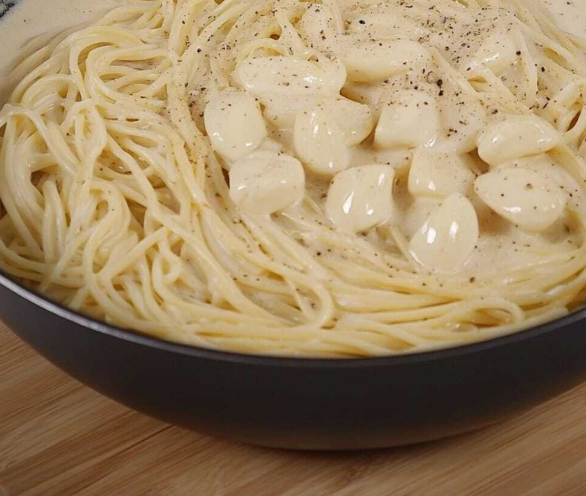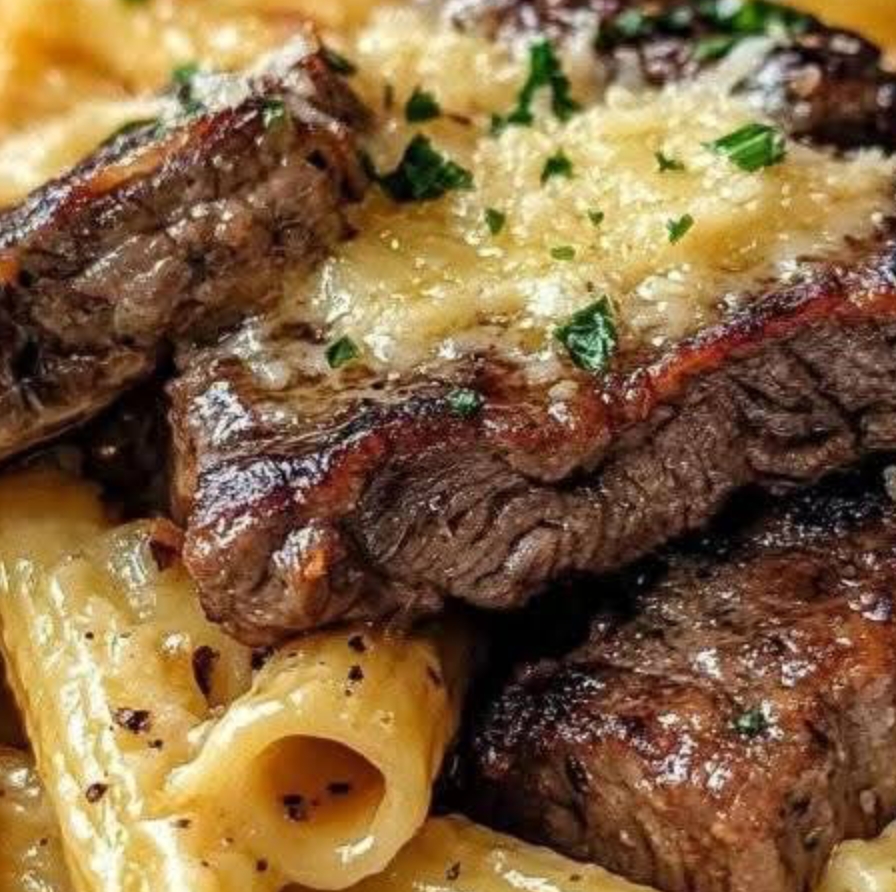Creamy Garlic Pasta 🍝🧄
If you’re craving a dish that’s indulgent, comforting and simple yet elegant—this Creamy Garlic Pasta is your answer. Silky heavy cream, melted Parmesan, smashed garlic cloves, and perfectly‑cooked pasta combine into one satisfying bowl of deliciousness.
Introduction
There’s something beautifully comforting about pasta in a rich garlic sauce: the aroma of sautéed garlic, the velvety sauce pooling around strands of spaghetti, the warm and satisfying bite. Whether it’s a busy weeknight or a relaxed dinner with friends, this dish hits the spot. In this article you’ll find:
• A full ingredient list and step‑by‑step instructions
• Expert chef insight (from Gordon Ramsay) to elevate your technique
• Health & safety considerations to keep in mind
• A nutrition & health‑benefits table with measurements
• 10 detailed FAQs to answer your questions
• Internal links to related articles on www.freshtonerhungar.com
So let’s dive into this creamy garlic delight!
Ingredients
- Spaghetti or pasta of choice — 300 g (≈10 oz)
- Garlic cloves, peeled and smashed — 6‑8
- Butter — 2 Tbsp
- Olive oil — 1 Tbsp
- Heavy cream — 1 ½ cups
- Parmesan cheese, grated — ½ cup
- Black pepper, ground — ¼ tsp
- Salt — to taste
- Fresh parsley or basil, chopped (optional garnish)
- Red pepper flakes (optional for heat)
Why these ingredients?
The spaghetti provides the foundation—choose your preferred shape and texture. The smashed garlic cloves release bold flavour when sautéed, the butter plus olive oil form the base of your sauce yielding richness and velvety texture. Heavy cream adds that luscious, silky feel. Grated Parmesan melts into the sauce and binds everything together. Black pepper gives subtle heat; salt brings out all the flavours. Fresh herbs and red pepper flakes are optional finishing touches that add brightness and contrast.
Instructions
- Cook the Pasta: Bring a large pot of well‑salted water to a boil. Add the spaghetti and cook according to package instructions until al dente. Drain, but reserve about ½ cup of the pasta cooking water.
- Sauté the Garlic: In a large skillet, heat the butter and olive oil over medium heat. Add the smashed garlic cloves and sauté for about 3‑4 minutes, stirring occasionally, until the garlic turns golden brown and gives off a fragrant aroma. Be careful not to burn the garlic (burnt garlic can become bitter).
- Add the Cream: Once the garlic is golden, reduce the heat to low and pour in the heavy cream. Stir gently to combine and let the cream warm through for about 2‑3 minutes.
- Stir in Parmesan and Season: Add the grated Parmesan cheese to the skillet and stir continuously until it melts into the sauce and you have a smooth consistency. Season with the ground black pepper and salt to taste. If the sauce becomes too thick, add a splash of the reserved pasta water to loosen it.
- Combine Pasta and Sauce: Add the cooked spaghetti into the skillet. Toss it in the creamy garlic sauce until each strand is well coated. If necessary, add a little more pasta water to help the sauce cling to the noodles and maintain a smooth texture.
- Serve: Once the pasta is fully coated and ready, remove the skillet from heat. Serve immediately, garnished with fresh parsley or basil and optionally a sprinkle of red pepper flakes for heat.
Chef Gordon Ramsay’s Pro Tip
“Don’t rush the garlic step. Give it time to become golden and fragrant—not brown and burnt. Use the pasta water to finish the sauce—it’s the secret to a sauce that clings beautifully. And always serve pasta the moment it’s done so you get that peak texture.”
Health & Safety Considerations 🧂
- Avoid burning the garlic: Burnt garlic can impart a bitter taste to the dish. Sauté over medium heat and watch the colour carefully.
- Use heavy cream appropriately: Heavy cream adds richness, but also calories and saturated fat—so moderate portions are wise if you’re monitoring intake.
- Salt level: Remember the pasta water is salted, cheese is salty, and the sauce is rich—taste as you go so the dish doesn’t become overly salty.
- Pasta texture: Cook pasta to al dente—slightly firm to the bite—so it holds up when tossed in the sauce and doesn’t become mushy.
Nutrition & Health Benefits Table
| Ingredient | Approximate Quantity | Key Nutrients & Health Benefits |
|---|---|---|
| Spaghetti (300 g) | 300 g | Provides complex carbohydrates for energy; fibre if using whole grain option. |
| Garlic (6‑8 cloves ≈ 30 g) | ~30 g | Contains allicin, known for potential cardiovascular and immune benefits. |
| Butter (2 Tbsp ≈ 28 g) | 28 g | Contributes fat‑soluble vitamins and richness; moderation advised. |
| Olive oil (1 Tbsp ≈ 15 ml) | 15 ml | Rich in monounsaturated fats, supporting heart health when used as quality oil. |
| Heavy cream (1½ cups ≈ 360 ml) | 360 ml | Gives creamy texture; source of calcium and fat‑soluble vitamins—but also high in saturated fat. |
| Parmesan cheese (½ cup ≈ 50 g) | 50 g | High in calcium and protein; adds savoury flavour; high sodium—portion control matters. |
| Herbs & pepper & optional red pepper flakes | Variable | Adds micronutrients, flavour without heavy calories; red pepper flakes add a metabolism‑boosting heat component. |
Note: Because this pasta is rich and creamy, a standard portion will provide a significant amount of calories and fat. Serving with a side salad or steamed vegetables can help balance the meal.
Why This Recipe Works
This dish works because it balances rich and simple components. The toasted, smashed garlic infuses the sauce with deep flavour. The combination of butter + olive oil gives both richness and a lighter mouth‑feel. Heavy cream and Parmesan form a cohesive sauce that clings to the pasta, while the reserved pasta water helps create a silky texture and ensures the sauce binds with the noodles. Good technique—especially in timing and temperature—makes all the difference. Sources note that cooking garlic gently for longer enhances flavour, and using pasta water to emulsify leads to a more refined result. :contentReference[oaicite:1]{index=1}
For more pasta technique insight, check out our in‑depth article on mastering sauce emulsions and starter tips on www.freshtonerhungar.com.
Variations & Serving Suggestions
• Use whole wheat or gluten‑free pasta if needed for dietary preferences.
• Add sautéed mushrooms, spinach, or roasted vegetables to make it a more substantial meal.
• For extra protein, mix in grilled chicken strips, shrimp, or sautéed pancetta.
• Swap heavy cream for a lighter cream‑cheese or use part milk + part cream for a lighter sauce. (Some lighter versions have used cream cheese + vegetable broth successfully.) :contentReference[oaicite:2]{index=2}
• Top with fresh basil, parsley, or a sprinkle of lemon zest to brighten the flavour.
• Serve with a crisp side salad or steamed greens to contrast the richness.
10 Frequently Asked Questions (FAQs)
- Can I use other types of pasta besides spaghetti?
Yes — many long‑cut pastas such as fettuccine, linguine, or tagliatelle work well, as do shorter shapes like penne if you prefer. The key is having enough surface area for the creamy sauce to cling. - What if I don’t have heavy cream?
You can substitute with half‑and‑half or a mixture of milk + cream cheese, though the sauce will be lighter and less rich. One “healthier” version uses light cream cheese + vegetable broth for a lower‑fat option. :contentReference[oaicite:3]{index=3} - How can I prevent the sauce from becoming too thick or too thin?
If it becomes too thick, add a splash of the reserved pasta water to loosen it. If it’s too thin, let it simmer a minute or two longer so it reduces slightly, but stir to prevent burning. - Can I prepare the garlic ahead of time?
Yes — you can sauté the smashed garlic ahead, but keep it warm and add the cream sauce shortly before combining with pasta to preserve the fresh garlic flavour. - Is this dish suitable for vegetarians?
Yes — this recipe is vegetarian‑friendly (assuming you use vegetarian‑friendly Parmesan). You can easily omit any meat add‑ons and serve with vegetables. - What’s the best way to reheat leftovers?
Gently reheat on the stovetop over low heat with a splash of milk or water to restore sauce consistency. Avoid high heat which might curdle the cream. Leftovers are best eaten within 1‑2 days. - Can I make this gluten‑free?
Yes — simply use a gluten‑free pasta and ensure any added ingredients (e.g., grated cheese) don’t contain hidden gluten. The sauce ingredients themselves are naturally gluten‑free. - Does the garlic need to be smashed rather than minced?
Smashed cloves give more presence, the garlic nears‑whole retains shape, flavour and bite, while minced garlic will disperse and become more subtle. It’s more about preference—smashed garlic gives a noticeable texture and stronger statement. - What sides pair well with this creamy garlic pasta?
A crisp green salad with vinaigrette works well to cut the richness. Steamed or roasted vegetables (broccoli, asparagus, zucchini) also pair nicely. A simple bruschetta or crusty bread would round out the meal. - How can I make this dish a little lighter?
You can reduce the amount of heavy cream, substitute part of it with milk or light cream, use less butter, choose whole‑grain pasta, and add vegetables to increase volume without a lot of added fat. Also serve with fresh herbs and a side of veggies.
Conclusion
This Creamy Garlic Pasta recipe is one of those meals that feels indulgent but remains surprisingly simple. With minimal ingredients, good technique, and thoughtful touches, you’ll deliver a dish that’s creamy, garlicky, comforting—and entirely satisfying. Whether you’re cooking for yourself, your family, or guests, you can adjust and elevate it as you like.
For more pasta‑based meals, creamy sauces, and comfort‑inspired dishes, explore the additional recipes on www.freshtonerhungar.com. Enjoy every luscious forkful! 🍽️






